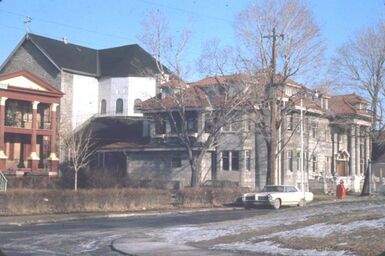 Ste-Anne’s Rectory beside Ste-Anne Hall, 1968
Ste-Anne’s Rectory beside Ste-Anne Hall, 1968 When constructed in 1921, Ste-Anne’s Rectory at 17 Myrand Avenue was the most elaborate building in this Lowertown Roman Catholic parish. It was designed by Ottawa architect Werner Ernst Noffke (1878-1964) for Monsignor Joseph Alfred Myrand, the priest who served Ste-Anne’s parish for fifty years. For Noffke, who later designed the Central Post Office, it was the first of multiple contracts with the Roman Catholic community in Ottawa. For Myrand, this large rectory signalled a strong francophone religious presence in the community, besides providing comfortable housing for him, his assistants and numerous visitors.
Father Myrand’s connection to Lowertown started in a house on St. Patrick Street, near the Cathedral. His father, Jean Baptist Myrand, worked as postmaster with the Legislative Council of the Province of Canada and after Confederation performed the same tasks with the Senate of Canada. Myrand took great pleasure in telling people that he was ordained in the same place where he was born, the building having become, by 1892, the Monastery of the Sisters of the Precious Blood.
Father Myrand’s connection to Lowertown started in a house on St. Patrick Street, near the Cathedral. His father, Jean Baptist Myrand, worked as postmaster with the Legislative Council of the Province of Canada and after Confederation performed the same tasks with the Senate of Canada. Myrand took great pleasure in telling people that he was ordained in the same place where he was born, the building having become, by 1892, the Monastery of the Sisters of the Precious Blood.

 RSS Feed
RSS Feed